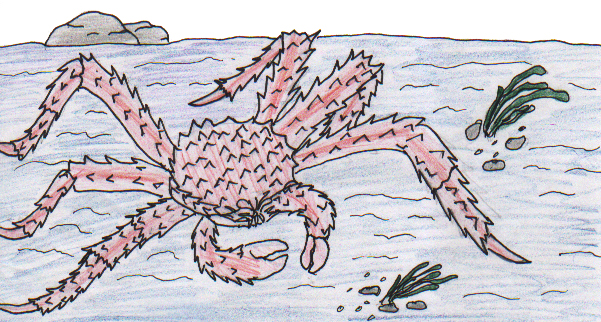 Marshall
Cultural Atlas Marshall
Cultural Atlas
This collection of student work is from
Frank Keim's classes. He has wanted to share these works for others
to use as an example of Culturally-based curriculum and documentation. These
documents have been OCR-scanned. These are available
for educational use only.
The King Crab
Paralithodes camtschatica
Yuale'rsaq
King crabs live the northern Pacific Ocean and
Bering Sea near the United States, Japan and the Russia. They are
also an important fishery in these areas.
King crabs aren't true crabs. Fleshy abdomens of
king crabs are compressed under their bodies and are covered by a
series of protective plates. The abdomen of the female crab is
fan-shaped and functions as a brood chamber for fertilized eggs. The
legs of a King crab are jointed to fold behind the body instead of
being jointed forward like the legs of true crabs. The legs and
carapace are spiny and provide protection from fish that prey on
them. They may grow as large as twenty-four pounds in fifteen years.
The commercially caught males are only about seven pounds and are
eight or nine years old. They are usually three feet long with their
legs extended.
King crabs display an annual migration pattern. In
late winter they move from the outer continental shelf to water
depths of less than 40 fathoms where females molt and are mated.
These mating grounds may be along the shore or on submerged offshore
banks. Crabs move to deeper water following mating and feed
throughout the summer, fall and early winter months.
Major fisheries for these crabs are centered at
lower Cook Inlet, Kodiak Island, Unimak Pass area, Adak and Atka
islands and the eastern Bering sea north of the Alaska Peninsula.
Minor fisheries are in Southeastern Alaska and the Shumagin Islands.
The crabs are caught with baited pots which are six or seven feet
square, three feet high and weigh 500- 700 pounds each. The pots are
baited with chopped herring which is usually replaced every two or
three days. The King crab fishery started in the early 1950's. The
most king crab ever caught was in 1966 when the fisheries caught 159
million pounds.
Charlotte
Alstrom

Christmastime Tales
Stories real and imaginary about Christmas, Slavik, and the New Year
Winter, 1996 |
Christmastime Tales II
Stories about Christmas, Slavik, and the New Year
Winter, 1998 |
Christmastime Tales III
Stories about Christmas, Slavik, and the New Year
Winter, 2000 |
| Summer Time Tails 1992 |
Summertime Tails II 1993 |
Summertime Tails III |
| Summertime Tails IV Fall, 1995 |
Summertime Tails V Fall, 1996 |
Summertime Tails VI Fall, 1997 |
| Summertime Tails VII Fall, 1999 |
Signs of the Times November 1996 |
Creative Stories From Creative Imaginations |
| Mustang Mind Manglers - Stories of the Far Out,
the Frightening and the Fantastic 1993 |
Yupik Gourmet - A Book of
Recipes |
|
| M&M Monthly |
|
|
| Happy Moose Hunting! September Edition 1997 |
Happy Easter! March/April 1998 |
Merry Christmas December Edition 1997 |
| Happy Valentine’s
Day! February Edition
1998 |
Happy Easter! March/April Edition 2000 |
Happy Thanksgiving Nov. Edition, 1997 |
| Happy Halloween October 1997 Edition |
Edible and Useful Plants of Scammon
Bay |
Edible Plants of Hooper Bay 1981 |
| The Flowers of Scammon Bay Alaska |
Poems of Hooper Bay |
Scammon Bay (Upward Bound Students) |
| Family Trees and the Buzzy Lord |
It takes a Village - A guide for parents May 1997 |
People in Our Community |
| Buildings and Personalities of
Marshall |
Marshall Village PROFILE |
Qigeckalleq Pellullermeng ‘A
Glimpse of the Past’ |
| Raven’s
Stories Spring 1995 |
Bird Stories from Scammon Bay |
The Sea Around Us |
| Ellamyua - The Great Weather - Stories about the
Weather Spring 1996 |
Moose Fire - Stories and Poems about Moose November,
1998 |
Bears Bees and Bald Eagles Winter 1992-1993 |
| Fish Fire and Water - Stories about fish, global warming
and the future November, 1997 |
Wolf Fire - Stories and Poems about Wolves |
Bear Fire - Stories and Poems about Bears Spring,
1992 |
|